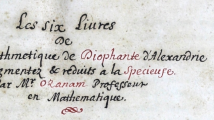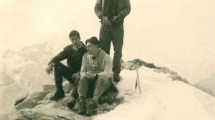Abstract
Despite the fact that Eri Jabotinsky (1910–1969) published only few (i.e. fourteen) mathematical papers, some of them had a remarkable influence in iteration theory. But also his life was remakable. Eri was the son of the famous Zionist Revisionist leader Vladimir Ze’ev Jabotinsky. Eri Jabotinsky was active in the Zionist movement and later as parlamentarian in the Knesset. Here we give an outline of his live and a complete list of his publications.
Similar content being viewed by others

Eri (Ari) Jabotinsky (1910–1969)
1 The Jabotinsky equations
As a mathematician Eri Jabotinsky is known for his system of differential equations, derived from the Translation Equation
For real or complex n-dimensional functions the “Jabotinsky equations” read as follows.
together with the differential initial conditions
These equations were published by Jabotinsky in 1963 in: “Analytic iteration”, Trans. Amer. Math. Society 108 (3), 1963, 457–477, but also before, in 1955, in his thesis at the Hebrew University, Jerusalem.
The notation above is due to György Targonski: “ Topics in iteration theory” [3] and “New directions and open problems in iteration theory” [4].
Later on it was noticed that these equations (1)-(3) had previously been considered by others in connection with iteration theory, e.g. by J. Aczél; therefore these equations are called by Ludwig Reich (e.g. [2]) and other authors the “Aczél-Jabotinsky” equations.
Furthermore, I discovered that in 1874 the famous logician Gottlob Frege considered in his habilitation thesis all these three differential equations in connection with analytic iteration for real functions in one and also several variables (see Gronau [1]).
Subsequently several other “Jabotinsky papers” appeared by J. Aczél, C. Cap, P. Erdős, H. Fripertinger, W. Jabłoński, L. Reich, M. Sablik, J. Schwaiger, Gy. Targonsky, J. Tomaschek, myself and, in the meantime probably by some others.
2 Short biography of Eri Jabotinsky
Eri (also transliterated “Ari”) Jabotinsky was born in Odessa (Ukraine) on December 26, 1910. His father was Vladimir (Ze’ev) Jabotinsky, a Russian Jewish Revisionist Zionist leader, author, poet, orator, soldier and founder of the Jewish Self-Defense Organization in Odessa.
2.1 Vladimir Ze’ev Jabotinsky, 1880–1940
Vladimir Ze’ev Jabotinsky was born as Vladimir Yevgenyevich Zhabotinsky, (

) in Odessa, October 5 (17), 1880 and died in New York, August 3, 1940. Vladimir grew up in Odessa and was educated in Russian schools also taking Hebrew lessons. Already in his youth he was active as a journalist and later (1903) in the Zionist movement. He changed his name from Vladimir to Ze’ev (this means ‘Wolf’) and began to work on organizing defense for Jewish communities all across Russia.
In World War I Ze’ev Jabotinsky was one of the founders of the Jewish Legion of the British army. Later he established several militant Jewish organizations in Palestine, e.g. the Irgun.Footnote 1
In 1923 after differences between him and Chaim Weizmann he established a new revisionist party called “Alliance of Revisionists–Zionists”.
Besides his journalistic and political work, he published novels, e.g. Samson the Nazarite (Richter und Narr) in 1927 and The Five (Die Fünf) in 1935, both of which are available also in German under the author’s name Vladimir Jabotinsky.
Ze’ev Jabotinsky died of a heart attack in 1940 in the USA close to New York City. In 1964 the remains of Ze’ev Jabotinsky and his wife were reburied in Mount Herzl Cemetery in Jerusalem by order of Israeli Prime Minister Levi Eshkol.
In Israel 57 streets, parks and squares are named after Jabotinsky, more than any other person in Jewish or Israeli history, making him the most-commemorated historical figure in Israel.Footnote 2
2.2 Eri Jabotinsky, 1910–1969
In 1919 when Eri was nine years old the Jabotinsky family emigrated from Odessa to the Mandatory Palestine.

Eri with parents around 1920
Following the arrest of his father in 1920, Eri left the country and moved to France, where he attended high school in Paris, and later earned a degree in electrical engineering. Between 1933 and 1935 he worked as an engineer for an aircraft factory. In 1935 he returned to Palestine, and worked as an engineer at the Naharayim power station in the Jordan Valley.Footnote 3

Eri Jabotinsky in Betar uniform, 1937
Eri Jabotinsky was a member of the Revisionism’s Betar youth movement and he became one of its representative leaders in 1936. He was also a member of the high command of Irgun and was sentenced to a jail term in Acre for a retaliation operation in Jerusalem and for transporting illegal immigrants. Before his arrest, Eri Jabotinsky, within the Bergson Group (Hillel Kook), succeeded in bringing in two more ships from Rumania with hundreds of immigrants at a time when World War II was already at its height.Footnote 4
In 1949 Eri Jabotinsky was elected to the first Knesset as a member of the Herut party’s list of candidates. He was married to Aviva Kugan and had two children.
After leaving the Knesset, he was awarded a PhD in mathematics in 1957 from the Hebrew University of Jerusalem. He lectured, among others, on electricity theory at the Technion-Israel Institute of Technology in Haifa between 1955 and his death in 1969.
The Jewish Telegraphic Agency wrote in his ‘JTA daily news bulletin’ from Monday, June 9, 1969:Footnote 5
TEL AVIV: Prof. Eri T. Jabotinsky, son of the late Vladimir Jabotinsky, Zionist Revisionist leader, died here on Friday, after returning from a lecture tour given for Israeli soldiers in Sinai and the Suez Canal areas. He was 59. Prof. Jabotinsky, born in Odessa, came to Palestine with his father. He was a professor of mathematics at the Haifa Technion and was co-founder of the right-wing faction of the Herut Party—the free center—with Shmuel Tamir.
3 Papers of E. Jabotinsky
Eri Jabotinsky published according to AMS Mathematical Reviews fourteen mathematical papers, among them two with Paul Erdős. Four of these papers deal with analytic iteration.
-
1.
Jabotinsky, Eri: A rapidly convergent series for the Weierstrass elliptic function. (Hebrew) Riveon Lematematika 1 (1946), 30–31. (Reviewer: A. Erdélyi).
-
2.
Jabotinsky, Eri: Sur la représentation de la composition de fonctions par un produit de matrices. Application à l’ itération de \(e^z\) et de \( e^z-1\). (French) C. R. Acad. Sci. Paris 224 (1947), 323–324. (Reviewer: A. J. Macintyre).
-
3.
Jabotinsky, Eri: Sur les fonctions inverses. (French) C. R. Acad. Sci. Paris 229, (1949), 508–509. (Reviewer: A. J. Macintyre).
-
4.
Jabotinsky, Eri: The minimal Tarry-Escott problem. (Hebrew) Riveon Lematematika 4 (1950). (Reviewer: D. H. Lehmer).
-
5.
Jabotinsky, Eri: Representation of functions by matrices. Application to Faber polynomials. Proc. Amer. Math. Soc. 4 (1953), 546–553. (Reviewer: A. Pfluger).
-
6.
Jabotinsky, E.: Iterational invariants. Technion. Israel Inst. Tech. Sci. Publ. 6 (1954/5), 64–80. (Reviewer: A. J. Macintyre).
-
7.
Jabotinsky, E.: A tentative explanation of the Weissenberg and Reiner effects by postulating the existence of gyroscopic phenomena in viscous flow. Bull. Res. Council Israel. Sect. A. 6 (1956), 65–76. (Reviewer: A. M. Freudenthal).
-
8.
Gutwirth, A.; Jabotinsky, E.: An alignment matrix and its applications to plane cubic curves and their rational points. Bull. Res. Council Israel. Sect. A 6 (1956), 11–41. (Reviewer: J. W. S. Cassels).
-
9.
Erdős, Paul; Jabotinsky, Eri: On sequences of integers generated by a sieving process. I, II. Nederl. Akad. Wetensch. Proc. Ser. A 61 = Indag. Math. 20 (1958), 115–128. (Reviewer: S. Chowla).
-
10.
Erdős, Paul; Jabotinsky, Eri: On analytic iteration. J. Analyse Math. 8 (1960/1961), 361–376. (Reviewer: J. Lehner).
-
11.
Jabotinsky, Eri: Analytic iteration. Trans. Amer. Math. Soc. 108 (1963), 457–477. (Reviewer: J. Mayer-Kalkschmidt).
-
12.
Jabotinsky, E.: l-sequences for nonembeddable functions. Proc. Amer. Math. Soc. 17 (1966), 738–741. (Reviewer: I. N. Baker).
-
13.
Jabotinsky, E.: Universal relations between the elements of Grunsky’s matrix. J. Analyse Math. 17 (1966), 411–417. (Reviewer: W. K. Hayman).
-
14.
Jabotinsky, Eri: On the use of spherical means in hydrodynamics. Application to the study of the inception of turbulence. Israel J. Math. 9 (1971), 3–19. (Reviewer: C. Demuth).
Notes
Irgun was a Zionist paramilitary organization that operated in Mandate Palestine between 1931 and 1948. The Irgun has been viewed as a terrorist organization or organization which carried out terrorist acts. (Wikipedia ‘Irgun’.).
Wikipedia: ‘Ze’ev Jabotinsky’, see also http://www.betar.org.uk/betaris/zeev.php.
Wikipedia: ‘Eri Jabotinsky’.
See Rafael Medoff’s article from June 12, 2009 in Haaretz:
Eri Jabotinsky’s race against death (https://www.haaretz.com/1.5063693) and:
Dalia Ofer, Escaping the Holocaust: Illegal Immigration to the Land of Israel, 1939–1944. Oxford University Press.
References
Gronau, D.: Gottlob Frege, a pioneer in iteration theory. In: Reich, L., Smítal, J., Targonski, Gy. (Eds.) Iteration Theory (ECIT 94). Grazer Math. Ber. Nr., Vol. 334, pp. 105–119 (1997)
Reich, L.: Die Differentialgleichungen von Aczél-Jabotinsky, von Briot-Bouquet und maximale Familien konvergenter vertauschbarer Potenzreihen. Math. Res. 53, 137–150 (1989)
Targonski, Gy.: Topics in Iteration Theory. Vandenhoeck & Ruprecht, Göttingen (1981)
Targonski, Gy.: New directions and open problems in iteration theory. Ber. Math.-stat. Sektion, Forschungsz. Graz, Nr. 229 (1984)
Funding
Open Access funding provided by University of Graz.
Author information
Authors and Affiliations
Corresponding author
Additional information
Dedicated to Professor Ludwig Reich on the occasion of his eightieth birthday.
Publisher's Note
Springer Nature remains neutral with regard to jurisdictional claims in published maps and institutional affiliations.
Photographs: Archive of the Jabotinsky Institute in Israel.
Rights and permissions
Open Access This article is licensed under a Creative Commons Attribution 4.0 International License, which permits use, sharing, adaptation, distribution and reproduction in any medium or format, as long as you give appropriate credit to the original author(s) and the source, provide a link to the Creative Commons licence, and indicate if changes were made. The images or other third party material in this article are included in the article’s Creative Commons licence, unless indicated otherwise in a credit line to the material. If material is not included in the article’s Creative Commons licence and your intended use is not permitted by statutory regulation or exceeds the permitted use, you will need to obtain permission directly from the copyright holder. To view a copy of this licence, visit http://creativecommons.org/licenses/by/4.0/.
About this article
Cite this article
Gronau, D. Eri Jabotinsky, mathematician and politician: a short biography. Aequat. Math. 95, 1149–1155 (2021). https://doi.org/10.1007/s00010-021-00779-w
Received:
Revised:
Accepted:
Published:
Issue Date:
DOI: https://doi.org/10.1007/s00010-021-00779-w




